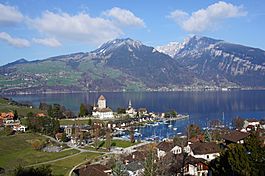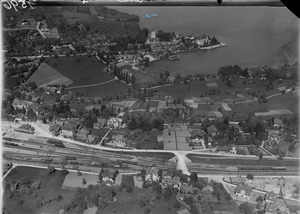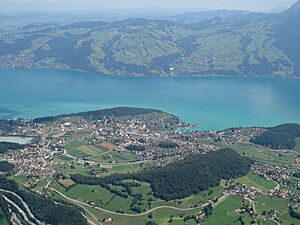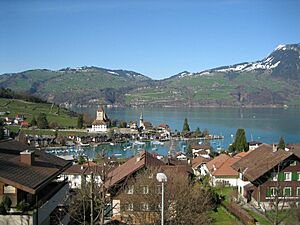Spiez facts for kids
Quick facts for kids
Spiez
|
||
|---|---|---|
 |
||
|
||
| Country | Switzerland | |
| Canton | Bern | |
| District | Frutigen-Niedersimmental | |
| Area | ||
| • Total | 16.69 km2 (6.44 sq mi) | |
| Elevation
(Railway station)
|
628 m (2,060 ft) | |
| Population
(Dec 2020 )
|
||
| • Total | 12,926 | |
| • Density | 774.48/km2 (2,005.9/sq mi) | |
| Postal code |
3700
|
|
| Localities | Einigen, Hondrich, Faulensee, and Spiezwiler | |
| Surrounded by | Aeschi bei Spiez, Hilterfingen, Krattigen, Oberhofen am Thunersee, Reutigen, Sigriswil, Thun, Wimmis, Zwieselberg | |
Spiez is a beautiful town and municipality in Switzerland. It sits right on the shore of Lake Thun in the Bernese Oberland area of the canton of Bern. Spiez is part of the Frutigen-Niedersimmental region. Besides the main town, the municipality also includes the smaller villages of Einigen, Hondrich, Faulensee, and Spiezwiler.
The official language in Spiez is German. However, most people speak a local dialect called Alemannic Swiss German.
Contents
History of Spiez
Spiez has a long and interesting history. It was first mentioned in old records around the years 761-762, known then as Spiets.
Ancient Times in Spiez
Long ago, during the Bronze Age and Iron Age, people lived in the area around Spiez. This was between the Kander River and Lake Thun. Archaeologists have found three Bronze Age cemeteries here. These graves contained many cool items like bronze axes, knives, and cloak pins from about 1750 to 1500 BC.
On a nearby hill called Bürg, even more ancient items were found. These included knives, arrowheads, spearheads, and a horse's bridle. Another hill, Eggli, seemed to be a special religious place. People used it from about 1500 to 500 BC. They found a large granite block surrounded by ash from fires and thousands of broken pottery pieces.
Later, from the 4th to 2nd century BC, Celtic graves were found. These graves had fancy gold, amber, and glass jewelry. These items were brought all the way from over the Alps. A very rare funerary urn was also found in Faulensee from the 1st century BC.
Spiez in Roman and Medieval Times
During the Roman era, there wasn't a big town here. But some Roman coins and graves show that Romans were in the area. After the Roman Empire ended, several small settlements appeared in Spiez.
According to old stories, King of Burgundy, Rudolph II, built Spiez Castle in 933. Soon after, a noble family, the Freiherr von Strättligen, lived in the castle. Parts of the castle's walls and main tower were built in the 12th century. By the 13th century, the town of Spiez had grown up outside the castle.
In 1338, the castle and town were sold to Johann II von Bubenberg, a powerful leader from Bern. The Bubenberg family owned Spiez for a long time. They ruled the town and villages until the French invaded in 1798.
The old Church of St. Laurentius, next to the castle, is very old. It was first mentioned in 761–62. The church building you see today was built in the 7th or 8th century. Its underground crypt is from around the year 1000. Many old graves from the 7th and 8th centuries have been found outside the church. When Bern became Protestant in 1528, this church became the main church for the area.
Spiez Grows and Changes
The town of Spiez officially got its town rules in 1406. However, some citizens had special rights even earlier, in 1312. A town wall was built early on, but it was destroyed in a fire in 1600. Over time, the nearby villages became part of Spiez, and their residents became citizens.
After the French invasion in 1798, the von Erlach family lost their ruling power. But they still owned the castle until 1875.
Historically, people in Spiez grew fruit and vineyards along the lake. They also fished in the lake and transported goods by boat. The vineyards were very important until a disease destroyed the plants in 1900. There was a successful effort to restart wine growing in 1927.
The Kander River used to flood the villages often. But in 1711–13, the river was redirected into the lake, solving the problem. New roads and steamship docks in the 1800s made it easier to travel to Spiez. Because of its nice weather and good transport, Spiez became a popular health and spa town in the 19th century. Many hotels and resorts opened along the lake.
The arrival of railroads in the late 1800s and early 1900s greatly boosted tourism. These included lines to Thun-Interlaken, Zweisimmen-Montreux, and Frutigen-Lötschberg-Simplon. As more people moved to Spiez, new schools were built. In the 1980s, new highways (A6 and A8) further connected Spiez. The Kander Tunnel opened in 1990, helping to reduce noise and pollution.
Geography of Spiez
Spiez is located on the south side of Lake Thun. It stretches along a ridge that separates the lake from the Kander River. The lowest point is at the lake, about 558 meters (1,831 feet) above sea level. The highest point is on the Hondrichhügel ridge, at 852 meters (2,795 feet).
The municipality of Spiez includes five villages: Spiez, Einigen, Hondrich, Faulensee, and Spiezwiler. About 36% of the land is used for farming, and 29.9% is covered by forests. About 31.6% of the area has buildings or roads. Rivers and lakes make up 2.0%, and 0.9% is unproductive land.
Spiez Coat of Arms
The design on the municipal coat of arms is simple and striking. It shows three blue triangles pointing upwards from the bottom, on a silver background.
People of Spiez (Demographics)
Spiez has a population of about 12,417 people (as of December 2011). About 8.4% of the people living here are foreign nationals.
Most people in Spiez (about 94%) speak German as their main language. Other languages spoken include Serbo-Croatian (1.1%) and French (0.8%).
In 2008, about 48.5% of the population was male and 51.5% was female. About 26.1% of the people living in Spiez in 2000 were also born there. Many others were born in the same canton (43.4%) or elsewhere in Switzerland (16.7%). About 10% were born outside Switzerland.
As of 2011, children and teenagers (0–19 years old) make up 18.8% of the population. Adults (20–64 years old) are 59.2%, and seniors (over 64 years old) are 22%.
Population Growth Over Time
The population of Spiez has changed a lot over the years:

Things to See in Spiez
Spiez has some cool places to visit!
Spiez Castle
The medieval castle in town is from the 15th and 16th centuries. You can explore its grand halls, including a fancy banquet hall built in 1614.
The Spirit of Spiez
The Hotel Belvédère in Spiez was famous for hosting the Germany national football team during the 1954 FIFA World Cup. The team developed a special bond and spirit there, which people believe helped them win the world championship! This is known as "The Spirit of Spiez."
Important Heritage Sites
Several places in Spiez are listed as important heritage sites. These include:
- The Bürg archaeological site, with old settlement ruins.
- The Swiss Reformed castle church.
- Spiez Castle itself.
- The Weinbauernhof (a traditional wine farm).
Economy of Spiez
In 2011, the unemployment rate in Spiez was very low, at 1.37%. Many people work in Spiez. In 2008, there were 4,649 jobs in the municipality.
- About 155 people worked in farming and related businesses.
- 1,220 people worked in manufacturing and construction.
- 3,274 people worked in the service industry (like shops, hotels, and healthcare).
Many people who live in Spiez also work there. In 2000, about 51.4% of workers both lived and worked in the municipality. About 23% of workers used public transportation, and 47.2% used a private car to get to work.
Religion in Spiez
Based on the 2000 census, most people in Spiez (70.7%) belong to the Swiss Reformed Church. About 12.6% are Roman Catholic. There are also smaller groups of Orthodox Christians, other Christian churches, and Muslims. A small number of people are Buddhist or Hindu. About 5.77% of the population said they belonged to no church or were agnostic or atheist.
Education in Spiez
Education is important in Spiez. About 58.7% of the population has completed upper secondary education. Also, 19.2% have gone on to higher education, like a university.
The school system in the canton of Bern starts with one year of optional kindergarten. Then, students go to six years of primary school. After that, there are three years of lower secondary school. Students can then choose to continue their schooling or start an apprenticeship.
During the 2011–12 school year, 1,286 students attended schools in Spiez. There were:
- 9 kindergarten classes with 182 students.
- 35 primary classes with 630 students.
- 22 lower secondary classes with 444 students.
Spiez also has a regional library. In 2008, it had over 20,000 books and other media. It loaned out over 135,000 items that year!
Transportation in Spiez
Spiez is a very important place for trains! The Spiez railway station is a major junction for one of Switzerland's main north-south railway lines through the Alps. This is called the Simplon line.
Trains coming from Germany, Basel, and Bern pass through Spiez. From here, they go through two long tunnels in the Alps:
- The Lötschberg Base Tunnel (35 km or 22 miles long), which takes you to Brig in just 35 minutes.
- The Simplon Tunnel (20 km or 12 miles long), which leads to Italy and eventually Milan.
There's also an older, higher Lötschberg Tunnel (15 km or 9 miles long) that's still used and offers amazing views. The train lines connecting Bern and Interlaken are also served by various train companies. The Spiez–Erlenbach–Zweisimmen railway line is part of the famous Golden Pass Express, which travels between Lucerne and Montreux on Lake Geneva.
Famous People from Spiez
- Jakob Streit (1910–2009): A Swiss author and teacher who was born and died in Spiez.
- Maya Pedersen-Bieri (born 1972): A Swiss-Norwegian skeleton racer from Spiez. She won a gold medal at the 2006 Winter Olympics.
- Caroline Steffen (born 1978): A professional triathlete who was born in Spiez.
Images for kids
-
Spiez harbour and Lake Thun (around 1900).
See also
 In Spanish: Spiez para niños
In Spanish: Spiez para niños














